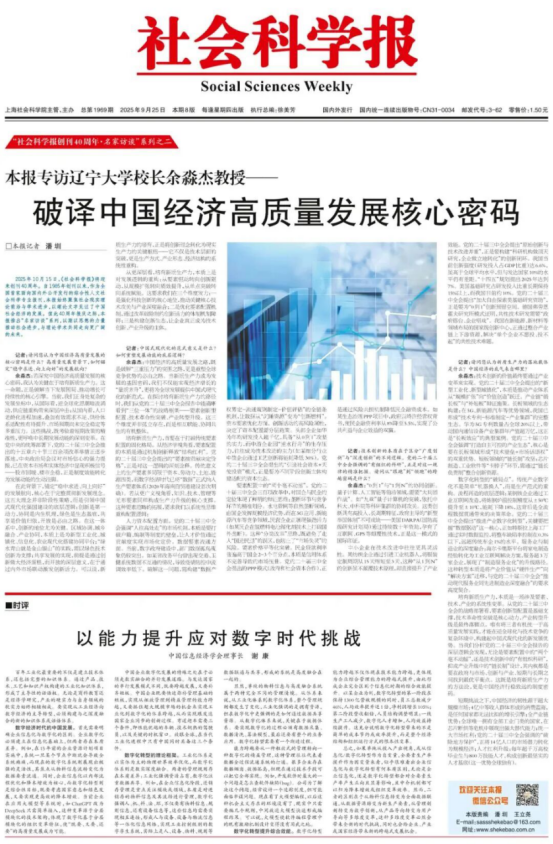Social Sciences Weekly made an exclusive dialogue with Professor Yu Miaojie, a deputy to the 14th National People’s Congress, a Fellow of the International Economic Association and president of Liaoning University (LNU) on the key to to China’s high-quality economic development.
The full text and link are as follows:


Reporter: In your opinion, what is the key to China’s high-quality economic development? And against this backdrop of high-quality development, how can we anchor our course towards “seeking progress through stability on a stable, upward trajectory”?
Yu Miaojie: If we delve into the key to China’s high-quality economic development, I believe it lies in fostering new-quality productive forces. Internationally, we are witnessing undercurrents of deglobalization, with supply chain restructuring creating profound shocks. Domestically, the accelerating aging of population is coupled with multiple pressures, including insufficient effective demand, a production system that needs better adaptation, and market expectations that are not yet fully stabilized. Under the centralized planning and deployment of the Party Central Committee, more than 300 reform measures outlined in the 60 sections across 15 chapters at the Third Plenary Session of the 20th CPC Central Committee are being gradually implemented. The strong boost to market confidence from the Political Bureau meeting has already shown positive signals in both the capital market and the real economy—the rebound in the stock market and the stabilization of the property market are vivid examples of institutional effectiveness being transformed into developmental momentum.
In this context, the core of seeking progress through stability on a stable, upward trajectory lies in the complete implementation of the new development philosophy. Innovation is the primary engine of development, coordination is an integral aspect of sustained and healthy development, sharing is the value refuge, and openness is the only way forward. Innovation is particularly critical. Regional coordination, urban-rural integration, and industrial synergy are essentially to build a collaborative platform for new industrialization, urbanization, informationization, and agricultural modernization; The practice of “Lucid waters and lush mountains are invaluable assets” needs to be supported by green technology innovation; The realization of shared development is based on making a big economic “cake” through innovation, and the deep meaning of openness lies in stimulating innovation vitality through the linkage between internal and external markets. The cultivation of new quality productive forces is the key hub to transform innovative ideas into real productivity. It is not only a breakthrough in technology, but also a systematic reconstruction of production modes, industrial forms and economic structure.
From a deeper perspective, fostering new-quality productive forces essentially entails a fundamental restructuring of the logic of development, a shift from factor-driven to innovation-driven growth, from scale expansion to quality and efficiency enhancement, and from isolated breakthroughs to systemic empowerment. This requires focused efforts in three dimensions: First, strengthening the core role of technological innovation by promoting the deep integration of breakthroughs in key core technologies with industries. Second, optimizing the factor allocation mechanism by using reforms to dismantle systemic and institutional barriers that constrain innovation vitality. Third, fostering an innovation ecosystem where enterprises truly become the main actors in technological innovation and industrial upgrading.

Reporter: What is the paradigmatic significance of Chinese modernization? And how does it reshape the underlying logic of developmental momentum?
Yu Miaojie: China’s path to high-quality economic development is not only a breakthrough in addressing the “triple pressures,” but also an essential route to rebuilding its global competitive edges. When discussing the pathways to foster new-quality productive forces, we can clearly discern a “trinity” strategic framework from the report of the Third Plenary Session of the 20th CPC Central Committee—the innovative allocation of factors, revolutionary breakthroughs in technology, and industrial transformation and upgrading.
The primary task in fostering new-quality productive forces lies in breaking the rigid structure of traditional factor allocation. From an economic perspective, the essence of factor allocation is to unleash “structural dividends” through institutional innovation. Traditionally, production factors were largely confined to four categories: capital, labor, land, and energy. However, the digital economy era has formally incorporated “data” into the production factor system. From a broader perspective, intangible factors such as knowledge, technology, and management also constitute core support for productivity upgrading. This expansion in the scope of factors requires us to reconstruct the allocation logic with systematic thinking.
Regarding Human Capital Allocation: The Third Plenary Session of the 20th CPC Central Committee emphasized a market mechanism where “talent flows to better opportunities,” which fundamentally aims to break down barriers created by systems such as household registration and permanent staff quotas, allowing the value of talent to be priced by the market based on their contributions. On the Circulation of Data Factors, currently in the development of digital government, data silos across departments remain prominent. Addressing this issue requires establishing a comprehensive mechanism covering “data property rights definition-circulation rule formulation-value assessment,” transforming data from a “dormant resource” into “fuel for innovation.” In terms of capital factor optimization: The high-risk nature of innovative activities necessitates a layered approach to capital allocation.
The “Two Unswervinglys” in Factor Allocation. Among the 300 reforms outlined at the Third Plenary Session of the 20th CPC Central Committee, the positioning of state-owned and private enterprises reflects distinct dialectical thinking: a precise division between monopolistic and competitive sectors. In natural monopoly areas such as water, electricity, and pipeline networks, state-owned enterprises leverage economies of scale, while in competitive fields like 5G applications and new energy vehicles, private enterprises are demonstrating robust dynamism. This “categorized reform” approach avoids both the misconception of “the state sector advances, the private sector retreats” and the risks of “market failures.” Breakthroughs should be made in factor price equalization.

Reporter: The essence of technological innovation lies in distinguishing the different logic of “breadth innovation” and “depth innovation.” The “organized research” emphasized by the Third Plenary Session of the 20th CPC Central Committee is a precise grasp of this principle. What is the key to achieving the leap from “catching up” to “leading”?
Yu Miaojie: It requires collaborative innovation spanning “from 0 to 1” and “from 1 to N.” In cutting-edge fields like quantum computing and artificial intelligence, we need “mass-force operations.” For instance, the breakthrough of the “Jiuzhang” quantum computer relied on the collaborative efforts of research clusters such as the University of Science and Technology of China and the Chinese Academy of Sciences. This type of innovation is characterized by high investment and long cycles, making the government-led new-type national system indispensable. The U.S. DARPA (Defense Advanced Research Projects Agency), through funding sustained for decades, gave birth to disruptive technologies like the internet and GPS, which serves as international validation of this model.
Small and medium-sized enterprises (SMEs) often demonstrate greater flexibility in technological improvements. The Third Plenary Session of the 20th CPC Central Committee’s proposal to “prioritize both original innovation and technological improvement” aims precisely to build an innovation closed loop where “research institutions conduct pioneering research while enterprises focus on practical application.” Although China’s current innovation intensity (R&D expenditure as a percentage of GDP) reaches 6.6%, exceeding the global average, it still lags behind the 10% level of developed countries. The 14th Five-Year Plan sets a target of 7% by 2025. The United States maintains a basic research share of over 15% in its R&D investment, while China’s current share is approximately 10%. The proposal to “increase funding for free-exploration basic research” at the Third Plenary Session is intended precisely to create space for “0 to 1” innovation.

Reporter: In your view, what serves as the tangible carrier for new-quality productive forces, and where does the confidence of the Chinese economy stem from?
Yu Miaojie: The value of technological innovation must ultimately be realized through industrial transformation. This involves a practical approach of “forging strong points” and “remediating weaknesses” in the industrial chains. In cultivating strong points: in leading sectors like 5G and new energy vehicles, China has established a comprehensive ecosystem spanning “technology patents-standard setting-industrial clusters.” The Third Plenary Session of the 20th CPC Central Committee emphasized “building a self-reliant and controllable industrial ecosystem,” the core of which is to form a dual advantages of “technological barriers” and “market voice” in these areas of strength. In addressing weaknesses, for “bottleneck” areas such as chip manufacturing and industrial software, a “chain-chief system” is essential to integrate innovation resources under a chain-chief responsibility mechanism.
The digital transformation of traditional industries is not merely about “replacing human labor with machines,” but rather a fundamental restructuring of the production paradigm. The underlying logic of process re-engineering: A steel company, through an industrial internet upgrade, can improve the precision of its furnace temperature control from ±50°C to ±10°C, while reducing energy consumption by 18%. This achievement stems from a decision-making revolution enabled by fully integrated data across the entire production process. The Third Plenary Session of the 20th CPC Central Committee’s proposal to “advance the digital transformation of industries” crucially hinges on grasping this core principle of “data-driven” operations. Deep integration of services and manufacturing: Haier’s COSMO Plat platform has transformed its home appliance manufacturing expertise into industrial internet solutions, serving over 30,000 enterprises. This exemplifies the upgraded pathway of servitization of manufacturing.
Cultivating new-quality productive forces is, in essence, a systemic transformation involving factors of production, technology, and industries. Viewing the strategic deployment of the Third Plenary Session of the 20th CPC Central Committee reveals that innovatively allocated factors of production provide the foundational support, revolutionary technological breakthroughs supply the core driving force, and industrial transformation and upgrading serve as the ultimate goal. Only by organically integrating these three aspects into the practice of high-quality development can China construct new advantages for its modernization in the complex environment of deglobalization and technological competition. When analyzing the deep logic of the report from the Third Plenary Session, we find that whether it is the “Two Unswervinglys” in factor allocation, the “organized research” in technological innovation, or the design of the “chain-chief system” in industrial upgrading, their core purpose is to find the optimal equilibrium between government and market, between innovation and industry, and between short-term and long-term objectives.

In the face of short-term challenges, the resilience of the Chinese economy stems from its super-large scale market. The consumption “blue ocean” created by its 400-million middle-income group is a growth engine unmatched by any other country. Its comprehensive industrial chain advantage, being the only nation with all industrial categories, has demonstrated a formidable capacity for substitution during crises such as chip supply cuts. The dividends of a unified national market are being realized as efforts to “eliminate local protectionism,” emphasized at the Third Plenary Session of the 20th CPC Central Committee, transforming the market potential of 1.4 billion people into economies of scale. The upgrading demographic dividend, with over 10 million university graduates and 8 million skilled vocational graduates annually, constitutes the most solid talent foundation for innovation—an unique advantage in the world.
Link:https://shekebao.com.cn/detail/2/28751